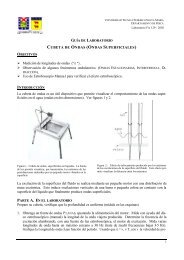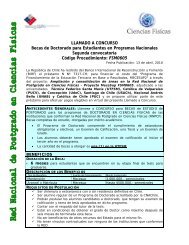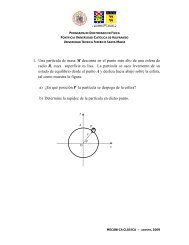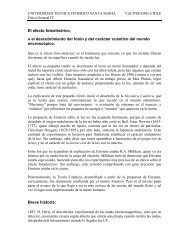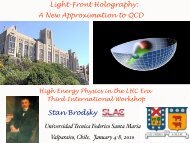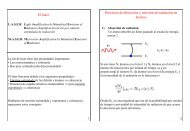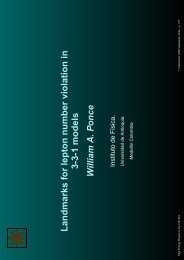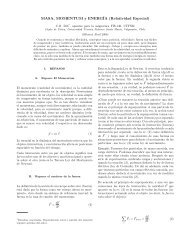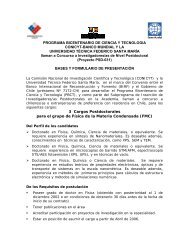Aca - Departamento de Física - Universidad Técnica Federico Santa ...
Aca - Departamento de Física - Universidad Técnica Federico Santa ...
Aca - Departamento de Física - Universidad Técnica Federico Santa ...
You also want an ePaper? Increase the reach of your titles
YUMPU automatically turns print PDFs into web optimized ePapers that Google loves.
V Encuentro Sud Americano <strong>de</strong> Colisiones Inelásticas en la Materia<br />
Secondary Ions emission from Alkanethiol-SAMs due to highly charged ions<br />
bombardment<br />
M Flores 1 , V. Esaulov 2 and Y. Yamazaki 3<br />
1 Depto. <strong>de</strong> <strong>Física</strong>, Facultad <strong>de</strong> ciencias físicas y matemáticas, <strong>Universidad</strong> <strong>de</strong> Chile, casilla 110-V, Santiago, Chile.<br />
2 Laboratoire <strong>de</strong>s Collisions Atomiques et Moleculaires, Universite Paris-Sud, Orsay Ce<strong>de</strong>x, France.<br />
3 Atomic Physics Laboratory, Riken Institute, Wako, Saitama, Japan.<br />
email address corresponding author: mflorescarra@ing.uchile.cl<br />
Self-assembled monolayers (SAMs) are<br />
or<strong>de</strong>red molecular assemblies formed by the adsorption<br />
of an active surfactant on a solid surface.<br />
SAMs provi<strong>de</strong> a convenient, flexible, and<br />
simple system with which to tailor the interfacial<br />
properties of metal, metal oxi<strong>de</strong>s and semiconductors<br />
[1]. The alkanethiols are a common type<br />
of molecules used to build SAMs.<br />
Several techniques have been used to<br />
study and characterize SAMs, for example SPM,<br />
optical and ion spectroscopies. In the latter case,<br />
the interaction of ions with SAM surfaces leads<br />
to the sputtering of molecules from the surface,<br />
with the <strong>de</strong>tection of such molecules giving information<br />
on both the chemical and structural<br />
composition of the SAM. For this reason much<br />
experimental and theoretical effort has been directed<br />
towards ion-SAM collisions. Special case<br />
is the highly charged ions (HCI).<br />
For slow HCI, the potential energy stored<br />
in the projectile can far exceed its kinetic energy.<br />
In contrast to the kinetic sputtering process,<br />
which is due to momentum transfer from the<br />
ion to the surface, HCI may also transfer significant<br />
potential energy, removing ions and molecules<br />
from the surface in a process called potential<br />
sputtering.<br />
SAMs of the alkanethiol molecules Un<strong>de</strong>canethiol<br />
(UDT), HS(CH 2 ) 10 CH 3 , and Do<strong>de</strong>canethiol<br />
(DDT), HS(CH 2 ) 11 CH 3 , were prepared<br />
on atomically flat Au(111) which was <strong>de</strong>posited<br />
as a thin film on freshly cleaved mica.<br />
The quality of the SAMs was confirmed by<br />
STM observations [2]. The samples were bombardment<br />
with Ar q+ ions.<br />
The q-<strong>de</strong>pen<strong>de</strong>nce of the proton sputtering<br />
yield from hydrogen contaminated/covered surfaces<br />
has been found to follow a power law <strong>de</strong>pen<strong>de</strong>nce<br />
and this was explained by the classical<br />
over barrier mo<strong>de</strong>l. In this mo<strong>de</strong>l a HCI approaching<br />
an atom/molecule induces multielectron<br />
transfer. In the case of our SAM it<br />
would induce electron transfer from the alkanethiol<br />
molecule terminal functional group.<br />
Removal of two electrons from the most external<br />
part of the SAM, would create a doubly charged<br />
chemical bond (C-H) 2+ . Because the molecule is<br />
a poor conductor, the reneutralization probability<br />
in the molecular layer should be lower than<br />
on a metal, and a proton may be released in the<br />
bond direction by Coulomb repulsion [3]. In<br />
general, in the above mo<strong>de</strong>l the proton yield is<br />
then <strong>de</strong>pen<strong>de</strong>nt on the probabilities of removal<br />
of the first and second electron and on reneutralization<br />
as the ion moves away from the surface,<br />
given a power law, Fig 1(a,b), and in the<br />
case un<strong>de</strong>r study the probabilities are strong <strong>de</strong>pen<strong>de</strong>nt<br />
of the orientation of the terminal functional<br />
group, Fig. 1(c,d).<br />
Figure 1. Proton Yields from (a)UDT and (b)DDT<br />
un<strong>de</strong>r bombardment with Ar q+ ions. Top surface<br />
scheme of the SAMs corresponding to (c)UDT and<br />
(d)DDT.<br />
References<br />
[1] Love et al, Chem. Rev. 105 (2005) 1103.<br />
[2] O’Rourke et al, Appl. Phys. Lett., submitted.<br />
[3] Flores et al, Phys. Rev. A79 (2009) 022902.<br />
54 Valparaíso, Chile



